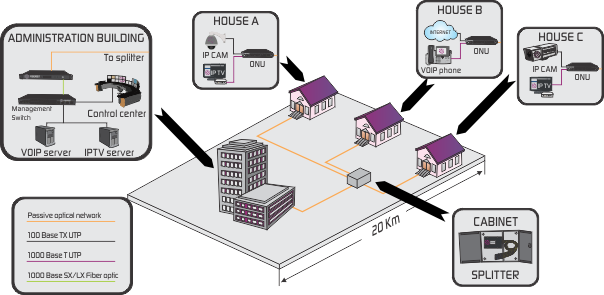
- EPON: FB-E-OLT-4PON-6GE supports IEEE802.3ah and PRC Community Industry Standard (YD/T 1475-2006).
- System’s capacity: The modularized PON card of FB-E-OLT-4PON-6GE can support four EPON systems simultaneously, up to 256 ONUs and the 1/64 coupling ratio.
- Uplink interface: Its flexible design supports various MAN interface type groups. The optical ports or the electrical ports are selected according to network conditions.
- Device size: A 1U device occupies a little space and consumes little power, decreasing the function cost of the services.
- Protecting the bus optical fiber: FB-E-OLT-4PON-6GE supports that the link can be automatically switched to protect the optical fiber when trouble occurs in the optical fiber.
- It is highly reliable and powered by two power sources.
- FB-E-OLT-4PON-6GE complies with IEEE802.3ah and P.R.C intercommunication standard, YD/T 1475-2006, supports CTC20/2.1, automatically discovers and cooperates with ONUs of different manufacturers.
- FB-E-OLT-4PON-6GE OLT supports the symmetric uplink/downlink 1.25Gbps PON transmission rate, efficient bandwidth usage and Ethernet services, helping carriers to provide reliable services to their users.
- Its coupling ratio, 1:64, and its support of different hybrid ONU networks minimize the carrier’s investment.
- FB-E-OLT-4PON-6GE , based on the edge-cutting technologies, is strong in functions. A few of its functions such as QoS guarantee, SLA and DBA can be easily listed out.
- It adopts the point-to-multipoint network topology, effectively collects separate Ethernet services and aggregates them on the MAN node. It connects the upper-layer devices through the GE interface and can be connected to the existing network smoothly.
- The Dynamic Bandwidth Allocation (DBA) mechanism enables all users to share the 1Gbps bandwidth reasonably, guaranteeing a reliable QoS.
- The Rapid Spanning Tree Protocol (RSTP) enables the redundant interconnection between OLT and backbone network, while EAPS provides highly reliable 50ms ring.
- They support the IGMP multicast and efficiently utilize the bandwidth. They support the multicast VLAN.
- It supports the broadcast of IPTV, voice and data simultaneously.
- It has rich OAM functions such as configuration, alarm, performance monitoring, trouble isolation and security management. At the same time, it supports the CLI/GUI management, which is easy to use.
4 PON port EPON OLT general specifications
Attributes
System’s capacity
Maximum coupling ratio, 1:64
32G backplane bandwidth
Main interface
6 GE ports (2 gigabit RJ45 ports, 2 combo ports, 2 gigabit optical ports)
4 fixed EPON ports
PON interface
A 1Gbps transmission rate with downlink and uplink symmetry
Average emitting power of the PON port: +2dbm ~ +7dbm
Light reception sensitivity of the PON port: no less than -30dBm
Security: ONU authentication mechanism
Network coverage diameter: 30 kilometers
Standard
IEEE802.3ahIEEE 802.1D, Spanning TreeIEEE 802.1Q, VLAN
IEEE 802.1w, RSTP
IEEE 802.3ad physical link static/dynamic aggregation (LACP)
Ethernet – II, Ethernet-SNAP
IEEE 802.3ad VLAN Stacking( Q in Q)Service quality
Backpressure flow control (half duplex)IEEE 802.3x flow control (full duplex)IEEE p802.1p, CoS
WR, SP and FIFO
Supporting the Mark/Remark priority of 802.1P/DSCP
Limiting the uplink/downlink rate based on each ONUSupporting DBA and SLA
VLAN
Port-based VLANGVRPIEEE802.1Q VLAN relay Supporting QinQ and flexible QinQ
Multicast
IGMP v1/v2/v3IGMP SnoopingMulticast VLAN and limited multicast Reliability
Unidirectional Link Detection (UDLD)Hot swap of the EPON optical module on the expanded slotEAPS fast loopback protection function
Optical path protection of EPONNetwork security
Limiting the maximum number of users on each portPort isolationControlling the storm of packets
Flow-based ACL access control function
DHCP snooping, Option82
IP source Guard
ARP inspectionTransmission data encryption on the PON interface
Configuration management
Various management modes such as CLI, SNMP, TELNETRMONv1, group 1, group 2, group 3 and group 9Upgrading the software and the bootrom through TFTP and FTP
Local or the server’s syslog logs
Command prompt in English or in Chinese
Network testing tools such as ping and tracerouteDebug output
Physical Characters
442mm(W) x315mm(D) x 44mm(H)
Installation: A 19-inch cabinet
Weight: 2kg
Environment requirements
Working condition: 0℃-55℃; 10%-85% no condensation Storage condition: -40℃-80℃; 5%-95%; no condensation Power source
Input voltage: AC100-240V
Input frequency: 47-63HzSupporting the input of two power sourcesInput current: 1A/230V
Power consumption: Up to 40W